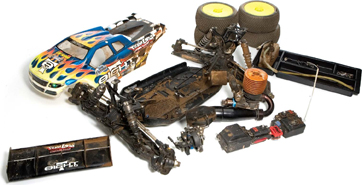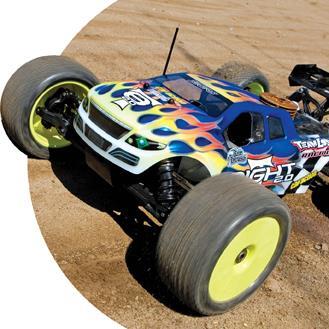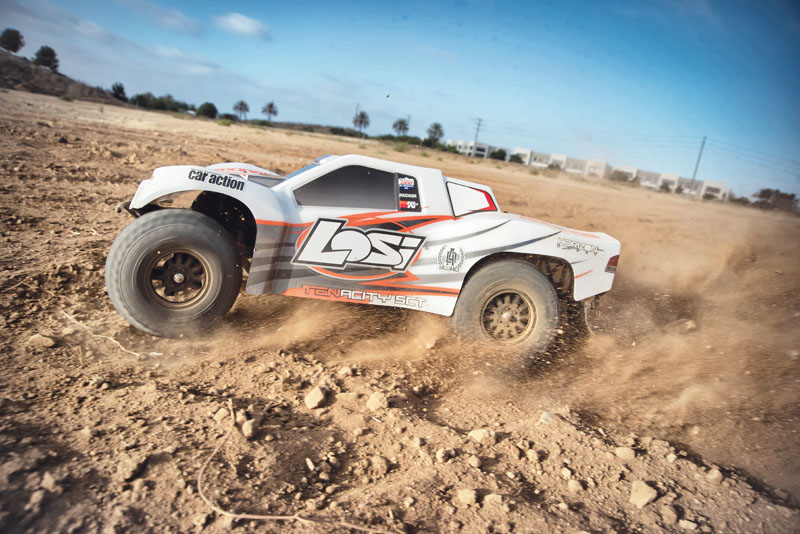Everyone wants to save money these days, but they still want to tear up the track. Believe it or not, simple maintenance of your race vehicle can allow you to do just that. Off-road vehicles such as nitro buggies and truggies take a lot of abuse on the track and that abuse will cause wear and can damage some parts. If you don’t maintain your vehicle, it won’t run as well as it did when it was new and you won’t have as much fun with it. A single part failure can also cause others to fail, which in the end, will cost you more money. When you’re finished with a weekend of racing, it’s a good idea to go through your vehicle and do some simple maintenance. This is not a time-consuming thing. It might take you about an hour or so max to get your vehicle ready for its next outing. Let’s go through the checklist.
RUN OUT ALL FUEL

After-run oil will save your engine from rust.
The first step (and one of the most important) is to lubricate your engine with after-run oil. Before you do that, you have to make sure you get all of the fuel out of the system. If you don’t, unburnt fuel inside the engine can attract moisture and that will rust your bearings and crankshaft. If this happens, you might as well throw your engine out. You need to start by emptying your fuel tank, then you can run the engine to get the remaining fuel out of the fuel lines and carburetor. To get the excess fuel out of your tank, simply stick the tip of your fuel bottle in the tank and use it to suck out the fuel. Place the vehicle on your bump box or on a block of wood to get the tires off the ground and fire up the engine. Once the fuel has burned off and your engine has stalled, you need to place a few drops of oil in the carb and inside the combustion chamber. Before you remove the glow plug to put the oil in the combustion chamber, you’ll want to remove any debris that has collected around the plug. Douse the area with motor spray, nitro spray, or fuel from your fuel bottle if you don’t have anything else. Once you have the oil in the carb and combustion chamber, put a rag over the head and turn the engine over for a second or two to disperse the oil.
BUY EARLY SAVE MONEY
When you race anything, you’re going to wear out parts or possibly break them due to hard racing. There are some parts that you should always keep in your tool box for when this type of thing happens. Parts such as front suspension arms, screws and shock towers are usually the first things that you’ll have to replace at the track. If you purchase them ahead of time, you can find those bargains out there and save some cash. If you don’t have the parts and have to pick them up at the shop that weekend, it might cost you a little more. And make sure you bring those parts with you to the track. You don’t want to get burned and have to purchase parts at the track that you already had.
CLEAN IT UP

Now disassemble your vehicle so that it’s easier to clean. You don’t need to take everything apart; removing everything from the center of the chassis is good enough.


Use a combination of Simple Green, denatured alcohol, and WD-40 to clean your vehicle. You can also use Pro Nitro Cleaner from T.A. Emerald.
Working on a dirty car is never fun and debris can get into places where you don’t want it. This being said, you should clean the vehicle before you do anything else. First, remove the tires and set them aside. Flip the vehicle over and remove any dirt from the screw heads with the tip of a hobby knife and a toothbrush. This will allow your screwdriver or Allen wrench to fully seat in the screws so you won’t strip out the head of the screw. Remove the fuel tank, center diff, radio tray, engine and exhaust. Getting all this stuff out of the center of the chassis will make it much easier to clean your vehicle. If you have a compressor, your life will be much easier but you can clean your vehicle without one. We’ll start with the compressor. Place the vehicle over a trashcan or on top of a large piece of cardboard so that you don’t get cleaning solution and debris all over the place. Spray your vehicle down with Simple Green and let it sit for a minute or so to let the Simple Green do its magic and loosen the debris and oil. Blow off the Simple Green with your compressor on its highest setting. You don’t need to get the nozzle too close to the chassis for this; a few inches away is good. Be careful around exposed bearings; you don’t want to force dirt into them. Then switch over to denatured alcohol and repeat the process to displace any water from the Simple Green. Finish with a coat of WD-40. Blow off the excess with your compressor and you will have a vehicle that looks like new. Removing the center diff ensures that you don’t get any WD-40 on your brakes. Clean the center diff assembly with a toothbrush and denatured alcohol. The rest of the parts can get the Simple Green, denatured alcohol and WD-40 treatment. Clean your air filter with soap and water before putting new oil on it. If you don’t have a compressor, skip the Simple Green and WD-40. Just use denatured alcohol and a toothbrush to knock off the grime. Wipe the parts down with a towel when you are finished. You can also use T.A. Emerald’s Pro Nitro cleaner.
INSPECTION TIME.

Pull on your tires to make sure the glue bond is still good.

Remove the clutch bell and check your clutch shoes. Look for wear and replace them if necessary.
Now that you have a clean car, look it over and check for loose screws or broken parts. You want to be thorough here because any part failures you find now are going to save you later. Remove the shocks and check to see that they operate smoothly and that your suspension moves freely. If your shocks or suspension aren’t smooth, chances are you have a bent shock shaft or hinge pin and you’ll have to replace them. Remove the clutch bell from the engine and make sure the clutch shoes and springs are in good condition. Spin the clutch bell to make sure the bearings are ok. Check the steering to ensure that it’s working properly. Grab the tires and look for tears or worn tread and try to gently pull them away from the rims to make sure they don’t need to be glued.
PUT IT BACK TOGETHER

Double check your servo arm alignment, linkage setup and end point adjustments when you put your vehicle back together.
When reassembling your vehicle remember to use thread-lock on all screws that thread into a metal part. If you have plastic screws that screw in a little too easy, pick up some plastic-specific thread-lock and put it on those screws. Check the alignment of your throttle and steering arms to make sure they are properly centered when the radio and receiver are turned on. Apply the brakes and make sure your brake bias is set correctly. Check the end points on your throttle, brake and steering: you don’t want the servos to over extend. If they do, you can damage the servos and or other parts on your vehicle. And don’t forget your blue thread-lock!
YOU’RE READY!
Now you’re ready to hit the track. Make sure that you store your vehicle with the tires removed from the chassis and put it in a dry location. If you leave the tires on, they can become flat sided from the weight of the vehicle pressing down on it. If you store your vehicle in a damp area, you may see rust starting to form on all your steel parts. When you’re ready to run again, charge the battery pack and have fun! This is something I do after every race and I rarely have part failures at the track.








![RC Car Action - RC Cars & Trucks | This 1/3 scale 125cc V10 Buggy is CRAZY [VIDEO]](https://www.rccaraction.com/wp-content/uploads/2018/05/V10-HP.jpg)


 Stay up to date with the latest information, sign up for our FREE newsletter today.
Stay up to date with the latest information, sign up for our FREE newsletter today.
